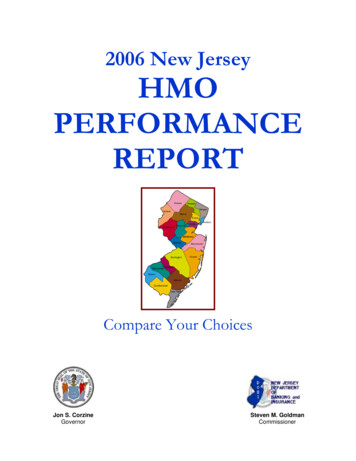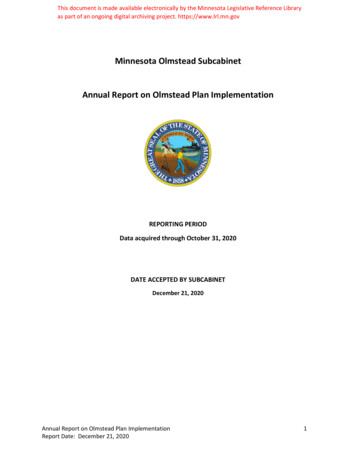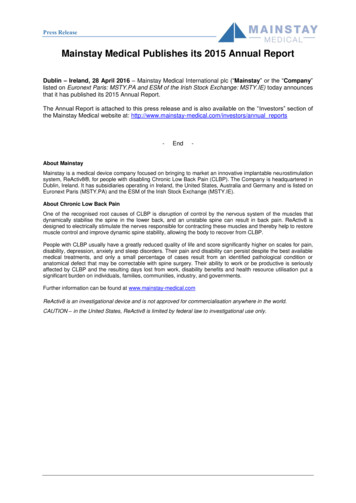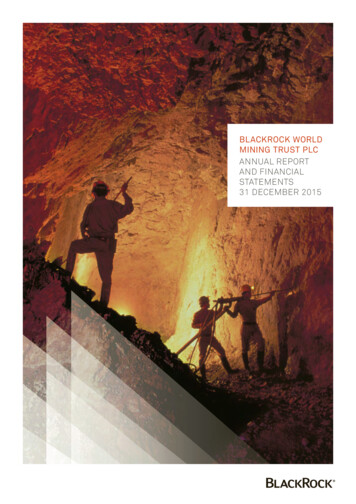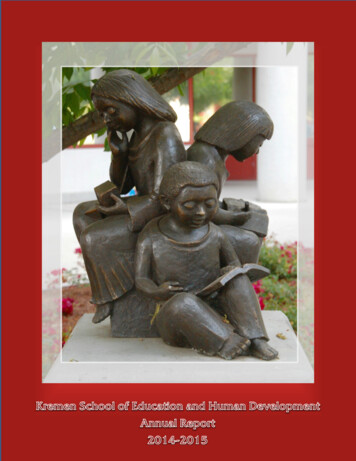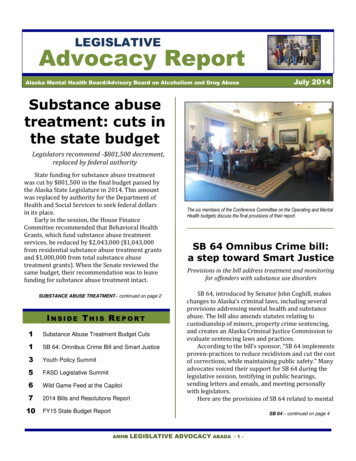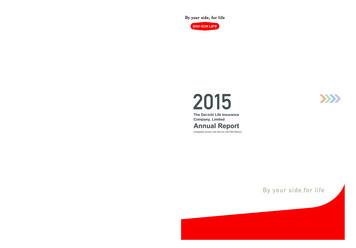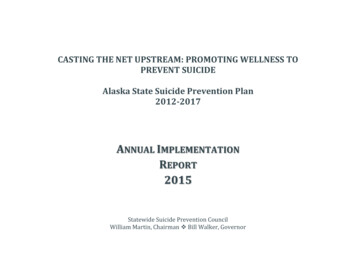
Transcription
CASTING THE NET UPSTREAM: PROMOTING WELLNESS TOPREVENT SUICIDEAlaska State Suicide Prevention Plan2012-2017ANNUAL IMPLEMENTATIONREPORT2015Statewide Suicide Prevention CouncilWilliam Martin, Chairman Bill Walker, Governor
IntroductionThe Statewide Suicide Prevention Council [“Council”] was established in 2001 bythe Alaska Legislature. The Council is responsible for advising legislators and theGovernor on ways to improve Alaskans’ health and wellness by reducing suicide,improving public awareness of suicide and risk factors, enhancing suicideprevention efforts, working with partners and faith-based organizations todevelop healthier communities, creating a statewide suicide prevention plan andputting it in action, and building and strengthening partnerships to preventsuicide. The Council was reauthorized by the Legislature in 2013, with a sunsetdate of June 30, 2019.Casting the Net Upstream: Promoting Wellness to Prevent Suicide is a call toaction. It acknowledges the most current research and understanding of the“web of causality” of suicide. Suicidal behavior results from a combination ofgenetic, developmental, environmental, physiological, psychological, social, andcultural factors operating in complex, and often unseen, ways. Specific strategieswere identified to achieve the goals and objectives of the suicide preventionsystem. These strategies come from the wisdom and experience of Alaskans.They are based on the most current and credible data and research available.Individuals, communities, and the State of Alaska can act together to implementthese strategies to prevent suicide.Casting the Net Upstream is a uniquely Alaskan endeavor. It is aligned with theNational Strategy for Suicide Prevention and the American Indian and AlaskaNative National Suicide Prevention Strategic Plan (2011-2015). Casting the NetUpstream encourages Alaskans to think about preventing suicide by promotingphysical, emotional, and mental wellness and strengthening personal andcommunity resilience. This is the third annual implementation report of suicideprevention efforts toward the Casting the Net Upstream goals.Statewide Suicide PreventionCouncil Members, 2015William Martin, ChairmanSen. Anna MacKinnonSen. Berta GardnerRep. Geran TarrRep. Benjamin NageakKathryn CaselloMeghan CrowCynthia EricksonSharon FishelBarbara FranksAlavini LataAlana HumphreyBrenda Moore-BeyersLowell Sage, Jr.Albert WallStatewide Suicide Prevention Council StaffJ. Kate Burkhart, Executive DirectorEric Morrison, Council Assistant2 Page
2015 Annual ReportIn addition to the activities and efforts described in this implementation report, the Council engaged in the following activities in2015: The Council held four public meetings: in person on Prince of Wales Island (May, 2015) and inFairbanks (September, 2015) and by teleconference in January, 2015 and July, 2015. The Council partnered with the Department of Education and Early Development to continue thecompetitive Suicide Awareness, Prevention, and Postvention [SAPP] grant program for school-basedsuicide prevention. Ten school districts were funded in 2015. The Council partnered with the Department of Education and Early Development to create a thirdonline eLearning module, “Responding to Suicide: Postvention Guidelines.” This module was approvedfor continuing education credits for social workers and nurses. The Council purchased 500 public seatsto provide these practitioners with access to the eLearning system. The Council partnered with the Alaska Community Foundation and Alaska Children’s Trust to continuethe Teen Suicide Prevention Grant Program. Twelve grants were awarded in 2015, totaling 54,699. The Council (staff and/or members, often with partner organizations) made educational presentationsat the Alaska Federation of Natives Convention, School Counselors Association Conference, SchoolHealth and Wellness Initiative Conference, Garrett Lee Smith Grantee Conference, Alaska StatewideSpecial Education Conference, and Statewide Independent Living Council. Education/awarenessbooths and public outreach were provided at the Alaska Federation of Natives Convention and theUniversity of Alaska Anchorage Suicide Prevention Week in 2015. The Council provided bracelets withthe Careline number, Careline magnets, and thousands of Careline brochures for suicide preventionevents sponsored by community coalitions, the Alaska State Troopers, the Rotary Club of Anchorage,and others.3 Page
Casting the Net Upstream GoalsGoal 1: Alaskans Accept Responsibility for Preventing SuicideGoal 2: Alaskans Effectively and Appropriately Respond to Peopleat Risk of SuicideGoal 3: Alaskans Communicate, Cooperate, and Coordinate SuicidePrevention EffortsGoal 4: Alaskans Have Immediate Access to the Prevention, Treatment,and Recovery Services They NeedGoal 5: Alaskans Support Survivors in HealingGoal 6: Quality Data and Research is Available and Used for Planning,Implementation, and Evaluation of Suicide Prevention Efforts4 Page
Regional Suicide Prevention TeamsWhen Casting the Net Upstream was released in 2012, the Council helped to create six regional suicide prevention teams: Northern,Interior, Southwestern, Anchorage/Mat-Su, Gulf Coast, and Southeastern. These teams are made up of key stakeholders and leadersin community suicide prevention efforts. Regional teams identified and work toward the state suicide prevention goals mostrelevant to their regions through specific action plans developed at the 2012 Statewide Suicide Prevention Summit and refined atthe 2014 “Tending the Net” Statewide Suicide Prevention Summit. Regional teams also help coordinate efforts and supportcommunication statewide.NORTHGoal 3INTERIORGoal 2, Goal 3,Goal 4ANCHORAGE/MAT-SUGoal 1, Goal 3, Goal 4SOUTHWESTGoal 2, Goal 3, Goal 4GULF COASTGoal 1, Goal 2, Goal 3SOUTHEASTGoal 1, Goal 3, Goal 45 Page
Suicide Rate and Number, 2014Data from the Bureau of Vital Statistics shows that 167 Alaskans died by suicide in 2014, resulting in a statewide suicide rate 19.522.8154127132149167140163141167Source: Department of Health and Social Services, Bureau of Vital Statistics201323.4171201422.7167Summary of Suicide Prevention ActivitiesThe number of community-based suicide prevention activities has grown steadily since 2010. This summary of projects andactivities provides a sample of Alaska’s evolving suicide prevention system.Suicide Prevention TrainingThe Alaska Army National Guard trains every service member every year in “Ask-Care-Escort(ACE),” a suicide prevention training model derived from the evidence-based Question-PersuadeRefer model. First line leaders receive ACE-Suicide Intervention, a more intensive skills training,at least once in their career. Alaska Army National Guard gatekeepers (behavioral health, familysupport, and other personnel) receive Applied Suicide Intervention Skills Training (ASIST).Alaska school districts offer suicide prevention trainings to educators and staff in order to meetthe requirements of the law passed in 2012. DEED reports that school districts offered training insafeTALK, Applied Suicide Intervention Skills Training (ASIST), and Gatekeeper QPR, as well asweb-based training from the eLearning System. The Department of Education and EarlyDevelopment (DEED) trained 3,079 Alaskans via the eLearning System in FY2015 (18% morethan in FY12014 and more than double the number trained in FY2013). Of those receivingtraining in FY2015, 2,120 completed the Suicide Prevention Part 1 eLearning Module and 959Alaskans completed the Suicide Prevention Part 2 eLearning Module.U.S. Army ACE Card6 Page
With a multi-year federal grant received from the Substance Abuse and Mental Health Services Administration (SAMHSA), DEED hasimplemented Project AWARE, which focuses on student mental health and wellness. Project AWARE supports Youth Mental HealthFirst Aid training for adults working with young people. Youth Mental Health First Aid is a nationally recognized evidence-basedtraining that equips participants to identify, engage, and assist someone experiencing a mental health challenge or crisis. Since April1, 2015, more than 900 people have received Youth Mental Health First Aid training.“I was so grateful for the tools. Especially the [listening]. . . Everything in me wanted to FIX this because she was so distressed, but I justlistened until she had exhausted everything within her. Knowing what to do kept me calm. . . pointing out that she had had the strengthto resist the unhealthy choices she wanted to make (self-medicating with illegal drugs) but had instead gone to the church seeking helpfrom known safe adults (using her resources wisely). We discussed the resources she had at her disposal and the coping strategies shehad learned and created a plan for follow-up. I asked for permission to be one of the resources and to stay engaged on a weekly basisand she indicated a desire to spend one afternoon a week together. . . Without the recent MHFA training, I think I would have insertedmyself too much into the process which would have cut short her need to dialog about her turmoil and would have robbed her ofownership of her solutions.”– Youth Mental Health First Aid Training participant, 2015Community Suicide PreventionThe Juneau Suicide Prevention Coalition continues to support suicide prevention inthe Juneau School District and wider community. The Juneau Coalition partners withthe school district and the Juneau Community Foundation to offer Sources ofStrength, an evidence-based peer leadership and resiliency building model, in thethree local high schools and one of the middle schools. Students, supported andtrained by adult mentors, are encouraged to use positive messaging to promotebetter health behaviors and prevent suicide. In 2015, the Juneau Coalition hosted asummit to educate nearly 200 community members about and develop responses tothe link between childhood trauma and suicide.Drew’s Foundation in Bethel continues to promote suicide prevention awareness,youth development, and wellness. Drew’s Foundation partners with local sled dogand snowmachine racers to share suicide prevention messages. It also supportsCouncil member Meghan Crow participates in the BethelWalk for Life, 2015 (photo courtesy of Drew’s Foundation)7 Page
healthy youth activities and public awareness events. Drew’s Foundation received the Calista Community Service Award in 2015.The Division of Behavioral Health (DBH) funded 19 comprehensive behavioral health prevention grantees in 2015. These granteesare all community coalitions focused on data-driven prevention activities:Nome Regional Wellness ForumNorth Slope Substance Abuse Prevention & Intervention CoalitionFairbanks Wellness CoalitionNulato Wellness CoalitionHooper Bay Community Planning GroupAlaska Alternative Schools CoalitionBethel Healthy Families CoalitionThrive Mat-SuAnchorage Communities Mobilizing for Change on AlcoholSpirit of Youth CoalitionAnchorage Youth Development CoalitionKenai Prevention CoalitionSeward Prevention CoalitionChenega Bay & Tatitlek Community CoalitionJuneau Suicide Prevention CoalitionKetchikan Wellness CoalitionPrince of Wales Behavioral Health CoalitionPetersburg Prevention CoalitionWrangell Early Prevention Coalition 150,000 134,942 260,000 95,848 150,000 350,000 150,000 260,960 264,458 257,092 342.473 150,680 150,000 149,853 284,000 150,000 224,802 123,480 95,582Grantee coalitions are required to address behavioral health issues that contribute to the “web of causality” for suicide throughstrict adherence to the Strategic Prevention Framework prevention model from the Substance Abuse and Mental Health ServicesAdministration (SAMHSA). Coalitions began with assessment of community needs, readiness, and resources related to behavioralhealth prevention. Based on the results of those community assessments, the coalitions will implement at least one environmentalstrategy (community-level prevention activities) and collect, monitor, and report local data related to grant activities. Coalitions thathad developed and/or implemented suicide prevention strategies under past DBH prevention grant programs – strategies which8 Page
may or may not align with the new grant requirements – have sought funding from local and other organizations to maintain theirefforts.Community coalitions, the Alaska chapter of the American Foundation for Suicide Prevention, and local organizations hosted suicideprevention awareness walks/runs across the state. The University of Alaska Anchorage hosted four events for Suicide PreventionAwareness Month (September). Council members Barbara Franks and Kathryn Casello assisted University staff and students to host“Who Has Helped You” activities to help people identify supportive relationships in their lives, as well as health promotion andeducation booths at the Student Union. The theme of these suicide prevention activities was Community Connectedness.The Alaska Community Foundation and the Alaska Children’s Trust funded 12 grantees in 2015 for the Teen Suicide PreventionGrant Program, totaling 54,699. Grants were awarded to:Camp Fire USA Alaska Council in AnchorageNative Village of White MountainNative Village of Shaktoolik IRA CouncilHuslia Tribal CouncilAlaska Native Tribal Health ConsortiumNorth Star Community FoundationArctic Resource Center for Suicide PreventionJuneau Youth ServicesNative Village of ElimNative Village of EyakMat-Su Resource Conservation & DevelopmentBrave Heart VolunteersSchool-Based Suicide PreventionFY2015 was the third year of the Suicide Awareness, Prevention, and Postvention [SAPP] grant program, implemented by DEED inpartnership with the Council. Ten school districts were funded to implement evidence-based suicide prevention in their highschools. All school districts receiving SAPP grants provide services to students at-risk of suicide. The North Slope Borough,Fairbanks, Juneau, Anchorage and Mat-Su Borough school districts implemented suicide prevention programs in alternative schools.The Haines and Petersburg school districts partnered with community behavioral health centers to expand students’ access tomental health services. The Northwest Arctic Borough and Bering Straits school districts continued peer leadership programs as thebasis of their suicide prevention programs. The Lower Yukon Kuskokwim School District focused on training community liaisonsand providing supports to at-risk students.9 Page
DEED’s Safe, Supportive, and Successful Schools Initiative is supported bythe Positive Behavioral Interventions and Supports, School Safety andHealth, Youth Risk Behavior Survey, Suicide Awareness and Prevention,and eLearning efforts, among others. This comprehensive approachfurthers the objectives of Alaska’s youth suicide prevention efforts andthe goals of Casting the Net Upstream. DEED, with the support of a grantfrom the Department of Health and Social Services, also continued thePromoting Health Alternative Schools and Community PartnershipsInitiative in 2015.Mat-Su Borough School District, ValleyPathways and Burchell High SchoolsYou Are Not Alone is a youth suicide prevention training program basedon the evidence-based Question-Persuade-Refer training model. You AreNot Alone was founded by Council member Kathryn Casello in 2013 and issupported by DBH and DEED, conducted trainings in schools acrossAlaska. You Are Not Alone events and trainings were held in 18communities statewide in 2015, reaching 1,296 students.This year both alternative schools had consistent on-site crisiscounseling support from Wasilla Behavioral Health. This hada very positive impact on helping the high number of studentsat risk for suicide. We feel confident the lives were saved dueto the crisis intervention provided from the SAPP grant.In FY15 there were a high number of students at risk forsuicide. This was demonstrated in the number of suicideinterventions completed at both alternative schools, whichresulted in numerous referrals to the ER, hospital admissionsand/or direct admits for inpatient care.Increasing Access to Prevention, Treatment, and Recovery ServicesWith a grant from the Substance Abuse and Mental Health Services Administration, DEED has funded mental health professionals inthe Anchorage, Mat-Su Borough, and Kenai Peninsula Borough school districts through Project AWARE. These counselors provideimmediate access to mental health assessment, services, and referrals for students at risk. Project AWARE includes the specificobjective of increasing the number of students referred to and accessing community behavioral health services by 25%. In othercommunities, long-standing collaborations help meet the behavioral health prevention, treatment, and recovery needs of students.Petersburg Mental Health Services, Inc., Juneau Youth Services, South Peninsula Behavioral Health, Family Centered Services ofAlaska, Providence Kodiak Island Counseling Center, and other behavioral health providers partner with local school districts tooffer mental health and substance abuse screening and treatment services to students at risk of suicide or severe emotionaldisturbances.Alaska Native Tribal Health Consortium funds a Rural Aftercare Coordinator at Alaska Psychiatric Institute to support patients fromrural communities admitted for suicidality to access treatment and support services in their home community after discharge. Thisculturally relevant form of discharge and transition support is designed to increase the likelihood of success in the home communityand reduce the need for repeat acute hospitalizations.10 P a g e
The Division of Behavioral Health reported that 23,950 Alaskans received community behavioral health services (mental health andsubstance abuse treatment) in FY2015. Residential psychiatric treatment centers served 461 youth in FY2015. Psychiatricemergency services were provided to 1,955 patients in local hospital mental health units and 1,559 patients were admitted toAlaska Psychiatric Institute in FY2015 (these are not unduplicated counts, as some patients could receive services locally and at APIin the same year).Supporting SurvivorsBereavement support groups and suicide survivors’ groups are available in Alaska. The Mat-Su Coalition for Suicide Prevention hostsurvivors support groups twice a month. Fairbanks Memorial Hospital’s Hospice Program hosts two support groups each month.Southcentral Foundation’s Denaa Yeets’ offers a weekly grief support group in Anchorage for people who have experienced a loss tosuicide.The Arctic Resource Center for Suicide Prevention (ARCSP) was founded in 2013 by a group of survivors of a loss to suicide andsurvivors of attempted suicide in Fairbanks. The ARCSP’s mission is “serving protectors and empowering survivors.” It is a resourcecenter and a catalyst for research on suicide in the Arctic. In 2015, the ARCSP partnered with an ecumenical group of clergy leadersto begin developing a faith-based suicide prevention curriculum for preaching ministers and a class to be held in January 2016. Formore information about the ARCSP, call Dr. James Wisland at (907) 750-5605.Data and Research DevelopmentThe Alaska Mental Health Board and Advisory Board on Alcoholism and Drug Abuse provideanalysis and reporting on the results of the Adverse Childhood Experiences (ACE) questionsasked in Alaska’s annual Behavioral Risk factor Surveillance System (BRFSS) survey. The BRFSSis an annual survey of adults conducted in every state. It is administered by the Division of PublicHealth in Alaska and is an invaluable source of information about the health behaviors andquality of life of Alaskans. The survey included ACE questions for the first time in 2013, collectingdata about Alaskans’ experiencing adverse childhood events such as the death of a parent, childabuse and neglect, childhood sexual abuse, parental substance abuse, and other traumaticexperiences. This data will inform statewide suicide prevention efforts, as these sorts oftraumatic events contribute to the “web of causality” of suicide (as well as many other health andsocial consequences).The 2014 BRFSS data on ACEs in Alaska showed that 66% of Alaskan adults surveyed had11 P a g e
experienced at least one ACE, and 19% had experienced four or more ACEs. Alaskans reporting four or more ACEs were far morelikely to report “fair to poor” physical health, and were more likely to report “frequent mental distress” and higher numbers of daysof poor mental health each month. A complete overview of the data and analysis is available online. For more information aboutthe ACE question module, contact Patrick Sidmore, Health Systems Planner II, Alaska Mental Health Board and Advisory Board onAlcoholism and Drug Abuse at (907) 465-8920.Note About the Implementation ReportThis report highlights key strategies where progress was achieved in 2015. In response to constituent input, an appendix has beenadded with a scorecard of all the Casting the Net Upstream performance measures. For information about a specific project, or toshare another suicide prevention program with the Council and its partners, contact Eric Morrison at (907) 465-6518.12 P a g e
Goal 1: Alaskans Accept Responsibility for Preventing SuicideStrategy 1.3 Alaskan youth seek out healthy and appropriate relationships with role models in their communityIndicator:1.3.a Traditional high school students participating in organized after-school activities 2 or more days a week:54.9% (YRBS, 2015) — compare to 44% in 20111.3.b. Alternative high school students participating in organized after-school activities 2 or more days aweek: 35.9% {YRBS, 2015) — compare to 35.1% in 2011Children and youth who are engaged in extracurricular and after-school activities have theopportunity to build and strengthen the developmental assets needed for healthdevelopment. Caring and appropriate relationships with adults outside of the young person’sfamily have significant influence on that youth’s development and resilience. When youngpeople engage in sports programs, music programs, church activities, scouting, or communityprograms like Big Brothers Big Sisters, they connect with strong role models and build asense of connectedness with their community. Boys and Girls Clubs of Alaska offer homeworkhelp, sports, nutrition, arts, and leadership programs to 2,975 young people each day in 32communities, most rural Alaskan communities. The Juneau After School Coalition wasestablished in 2009. This community organization provides critical afterschool programs likethe volunteer-supported BAM! (Body & Mind) After School program that engages middleschoolers in positive, healthy activities.Cooking Club at Boys & Girls Club ofFairbanksGoal 2: Alaskans Effectively and Appropriately Respond to People at Risk of SuicideStrategy 2.2 Alaskans know about Careline and other community crisis lines, and can share that information with others.Indicators:2.2.a. Number of calls to Careline annually: 13,558 — compare to 10,270 in 2014Careline is Alaska’s nationally accredited statewide suicide prevention and crisis call line. While Careline activity, includingincoming and outgoing calls and texts, was relatively stable from 2012 through the second quarter of 2014, contacts since then havedoubled. More Alaskans are reaching out for help, due in large part to coordinated and consistent media and outreach efforts13 P a g e
statewide. Careline strives to keep up with this demand, but the number calls transferred to the National Suicide Prevention Lifelinenetwork is increasing. Careline received 13,558 calls – including hang ups and wrong numbers – in 2015. Of these, 92% wereanswered by trained staff in Fairbanks. The remained were transferred to the National Suicide Prevention Lifeline because Carelinestaff was already responding to a call.Careline tracks the nature of the calls received (domestic violence, parenting, suicide, loneliness, etc.), and reports that the vastmajority of callers disclose a mental health and/or substance use disorder. Careline also conducts follow-up calls to monitor thesafety of callers and gauge the outcome (reduced risk, acceptance of follow-up, engagement in services, etc.) of the interventionsand information provided.Strategy 2.3 Providers of services to veterans will prioritize suicide prevention screenings and effective interventions.Indicator:2.3.a. Number of suicides among Alaska veterans: 11 (BVS, 2014) (compare to 30 in 2013)The Bureau of Vital Statistics collects data on veteran status on death certificates. Of deaths by suicide of Alaska residents occurringwithin Alaska in 2014, 11 were confirmed veterans (6.5% of the total of 167 deaths by suicide). This is a significant improvement inthe number and rate of veteran deaths reported by the Bureau of Vital Statistics.Goal 3: Alaskans Communicate, Cooperate, and Coordinate Suicide Prevention EffortsStrategy 3.2 The State of Alaska and its partners will make training in evidence-based suicide prevention and intervention modelsaccessible to all interested Alaskans.Indicator: 3.2.a. Number of Alaskans trained in suicide prevention/intervention: at least 8,714 — compare to est.5,010 adults and youth in 2014Many state, tribal, and community organizations provided suicide prevention trainings in 2015 – reaching an estimated 73% moreAlaskans than the year before. The vast majority of those trainings relied on an evidence-based training curriculum.14 P a g e
Evidence-Based Suicide Prevention and Intervention Trainings, 2015 SampleAgencyTrainingAlaska Native Tribal HealthConsortiumASISTsafeTALK35 adults & youthYou Are Not AloneYouth QPR1,296Alaska Training CooperativeMental Health First AidDept. of Education & EarlyDevelopmente-LearningYouth Mental Health First AidNumber Trained24 adults773 adults3,079 adults894 adultsAlaska Gatekeeper is based on the Question-Persuade-Refer model. Alaska Gatekeeper was developed by the Division of BehavioralHealth and Center for Behavioral Health Research and Services at the University of Alaska. This is a 2-hour training that providespeople with basic information and facts about suicide, how to recognize the warning signs of suicide, how to offer hope and connecta person at-risk to local help and resources.Alaska Gatekeeper has been the primary training offered by DBH to communities since 2003. It is offered by DBH staff and theAlaska Training Cooperative. In fiscal years 2014-2015, 3,812 individuals in 45 communities were trained in Alaska Gatekeeper. Ofparticipants surveyed after the training, 90% reported they would ask someone showing warning signs of suicide directly aboutwhether they were suicidal and 85% reported feeling confident in their ability to help someone at risk of suicide.Strategy 3.3 The State of Alaska will mandate evidence-based suicide prevention and intervention training for all school districtpersonnel.Indicator: 3.3.a. Number of school districts offering suicide prevention training to educators/staff: 54In 2012, the Alaska Legislature passed a bill that required teachers and certain other school employees (counselors, etc.) in grades7-12 to have two hours of suicide awareness and prevention training each year. The Department of Education and EarlyDevelopment, in partnership with the Council, developed an e-Learning module that complies with the statutory requirements. The2012 legislation was due to sunset in 2016. However, in 2015, the Alaska Safe Children’s Act was passed and signed into law. TheAlaska Safe Children’s Act requires domestic violence, sexual assault, and dating violence education for students and perpetuatesthe requirement of suicide training for educators and staff.15 P a g e
Goal 4: Alaskans Have Immediate Access to the Prevention, Treatment, and Recovery Services They NeedStrategy 4.1 Alaskans know who to call and how to access help — and then ask for that help — when they feel like they are in crisisand/or at risk of suicide.Indicator:4.1.a. Number of calls to Careline annually: 13,558 — compare to 10,270 in 2014See the discussion at Strategy 2.2 above for more about Careline resources.Goal 5: Alaskans Support Survivors in HealingStrategy 5.2 The State of Alaska will provide resources, tools, and technical support for community postvention efforts, withemphasis on natural, organic responses developed in the community.Indicator (revised): 5.2.a. Number of Alaskans trained in postvention: 132 (2015) — compare to 28 in 2014The Division of Behavioral Health has promoted the best practice Connect Training, designed by NAMI-New Hampshire, since 2012.CONNECT is a customizable model of suicide prevention and postvention training. In 2015, 132 individuals were trained in fourcommunities in the CONNECT model. The Helping Our Communities Heal Postvention Resource Guide, developed by the Council andDivision of Behavioral Health in consultation with a stakeholder advisory group is available on StopSuicideAlaska.org.Goal 6: Quality Data and Research is Available and Used for Planning, Implementation, and Evaluation ofSuicide Prevention EffortsStrategy 6.1 The State of Alaska will improve statewide suicide data collection efforts, employing epidemiological standards/ modelsto ensure quality reporting, analysis, and utilization for timely data driven policy decisions.Indicator:6.1.a. Data sources available on StopSuicideAlaska.org: 4 (2015) — compare to 3 in 2011StopSuicideAlaska.org includes data from the Centers for Disease Prevention and Control, the Alaska Division of Public HealthEpidemiology Section, the Alaska Violent Death Reporting System, and the Alaska Bureau of Vital Statistics.Efforts to improve use of statewide suicide data in policymaking improved in 2015. The Alaska Divisions of Public Health andBehavioral Health developed a partnership to improv
competitive Suicide Awareness, Prevention, and Postvention [SAPP] grant program for school-based suicide prevention. Ten school districts were funded in 2015. The Council partnered with the Department of Education and Early Development to create a third online eLearning module, "Responding to Suicide: Postvention Guidelines."
